 |
||
|
||
| ||
Part I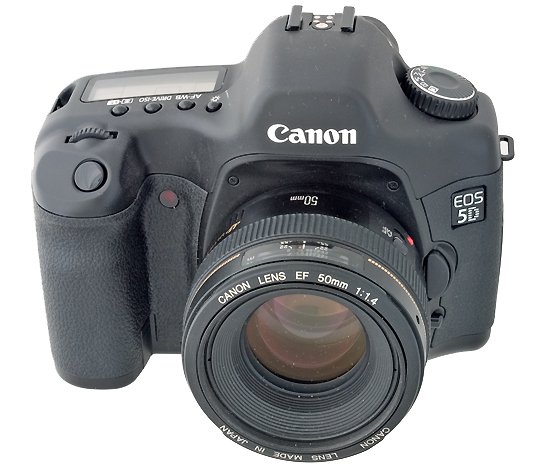 The camera was announced last year in August. Six months later I get down to its detailed review. In my opinion, this camera is just as popular now as it used to be. In particular, because EOS 30D was announced in February. Differences between these cameras come down to the sensor size (twice as large) and built-in flash. One of the reasons for the delay was that my camera got the fuse blown in 30 hours after I started testing it. The blown fuse is a mere nothing. But as its replacement is up to a certified service center, it left an after-taste of camera fragility and dependence on the service center, which also didn't contribute to fast testing. Describing the service would have taken up a separate article. I'll only note here that it's not just warranty repairs for expensive cameras. Perhaps, this service should be organized differently. Cameras for $3000 are means of production rather than toys. Two-week repairs of the camera, broken on the first day after it was purchased, do 100$ damage - that's the cost drop of such cameras. What functions are up to a service center and what should be granted to users? If a fuse blows out because of mishandling, the punishment of two-week idle time may be justified; but if it blows out for no obvious reasons or due to a manufacturing fault, it would have been better to allow users to replace a fuse on their own – without service centers. Intricate devices tend to fail from time to time, even Mars rovers break, though their quality control is much higher than that for cameras. If the manufacturer wants to make camera usage comfortable and as it's very difficult to provide 100% reliability, it should create at least an illusion of protection from possible breakages, that is to offer much faster services to users of expensive cameras, perhaps even to lend similar cameras for the repair time. If we assume that losses from an aborted order, real and potential, may equal the camera cost, using two cheap cameras becomes more justified than using a single but expensive camera. So, here are the key issues I want to touch upon in this part of the review. First. The camera has a new design, practically identical to 5D and 30D. The main difference from the previous generation is in a large display, both in terms of area and a number of pixels (2.5" in diagonal, 230 thousand pixels). Second. Twice as large sensor, what do we get for an extra thousand dollars? Exterior: comparison with the D60Why do I compare it with the D60? Well, first of all, I've got it :-). Secondly, it's compatible in terms of lenses and accessories. Thirdly, these very users who bought D60 cameras four years ago are likely to think about the replacement. And perhaps they will not be scared away by the price - they already paid it for their previous camera. Fourthly, for those who are addicted to the EF-S bayonet and have a series of corresponding lenses, it's a camera of a different system. So upgrading to this camera is similar to upgrading to a camera from another manufacturer. That is it will not be a replacement for them, but an additional camera in stock. This comparison is also interesting because sensors in these cameras are practically the same in size (8.2 micrometers in the 5D model and 7.4 micrometers in the D60) – twice as many pixels (12.7 millions versus 6.3 millions), twice as large sensor (24x36 mm versus 22.7 x 15.1 mm). That's why comparing noise characteristics of sensors in these cameras, we can see the evolution of these semiconductor devices: how much better is the quality of a sensor with the same surface area. 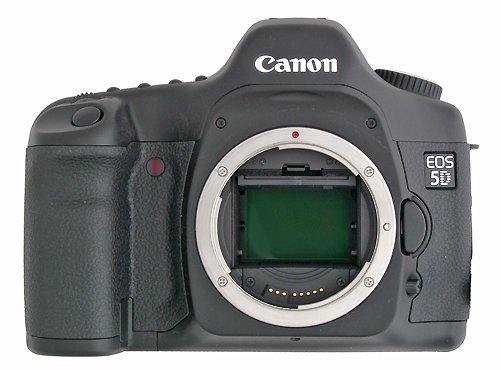 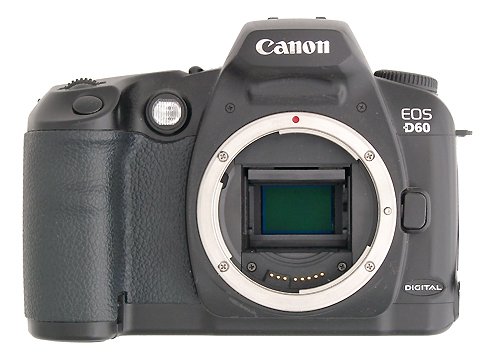 Front view. A large sensor and consequently a large mirror that shows 96% of the frame. Locked up mirror is much closer to the lens, which may create problems with some M42-threaded lenses. Though Zenit has a longer flange focal distance than in Canon EF, it allows deeper lens installation thanks to a smaller mirror and sighting area. So while there are no problems with D60 and all reflex cameras with the EF-S bayonet, they actually appear here. Moreover, the problems appear with wide-angle lenses, which are the best to use with a large sensor.  Pay attention to the arrowed locations. The 5D model lacks a mechanical switch of the electric lens interface. Only 1D models seem to retain it. 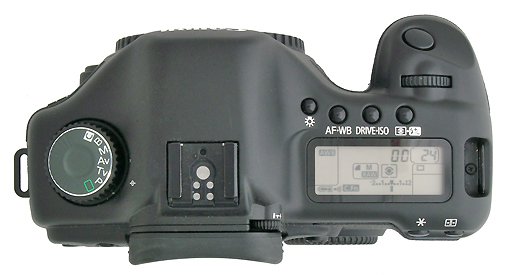 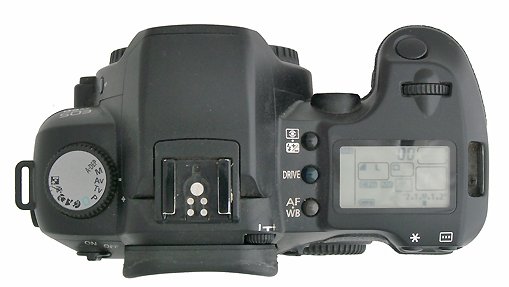
Top view. More rounded edges. Compared to later models 10D and 20D, the difference comes down only to no "scene" modes on the dial.  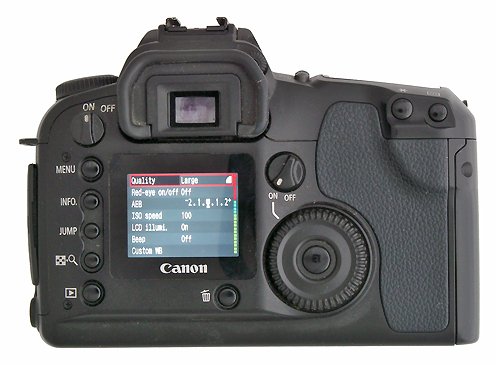 Rear view. The LCD display is much larger now, the LED indicator is moved. It indicates card activity, but it also lights up when you replace a lens on a switched-off camera. The on/off switch is moved and has a different function now. Instead of powering off a camera, it only locks the buttons.
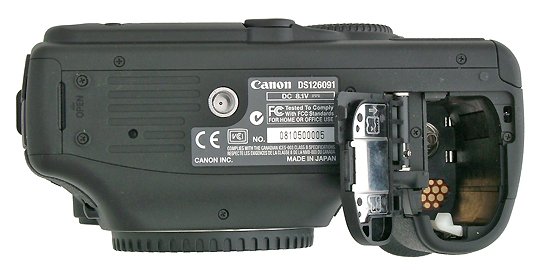  Bottom view. Backup battery bay is now in a different position. A battery bay is practically the same. The new camera uses a Lithium-Ion BP-511A 1390 mAh battery, but it can also use the old BP-511. There have been changed contacts for the accessory handle with batteries and the release button for shooting when the camera is in vertical position. The new camera uses the BG-E4 handle. In my opinion, the new handle is much more convenient than the old one, as it allows to use two Lithium-Ion BP-511 batteries as well as 6 x AA elements. The latter may be more efficient for taking photos in frosty weather or when stored charged up for a long time. This may be important in expeditions when you cannot charge your batteries.
MenuA large well-readable display with a localized menu. The main differences come down to an option to write photos in RAW and JPEG formats together, JPEG with adjustable size and quality. It's very convenient when you have to email your photos right away and you have no opportunity to process them on a computer. RAW files will be used for professional processing, which can be done later. The menu offers rich JPEG settings to convert photos into this format with the best quality and avoid further processing. User functions attracted our attention with an option for replaceable focusing screens. Firstly, by the fact itself that these screens can be replaced. Secondly, because the camera firmware adjusts to the screen type. The camera and lenses have become clever now, camera alignment can be done not only mechanically by moving the sensor and the focusing screens, but also on the software level. Service centers can even finetune the automated focus system for a given lens.
Why do we need a large sensor. About formats in digital photographyDigital photography today demonstrates the same tendency as is well known to tourists who go in for kayaking. Complexity grade of one and the same river differs by one for kayaks and catamarans. Areas of sensors and film frames often match. But these days we can expect a tad better results from a digital camera with the same frame area. Substandard cameras (frame format - 9x11mm) cannot compete today with digital cameras that have the same or even smaller sensor size. The next typical film size is 18x24. A cinema frame for 35mm cameras. A digital camera with a 3x4 sensor can compete well with it. I don't want to discuss the APS format - it's essentially similar to a cine frame and it has existed for such a short period that it's not clear why it's compared to the next digital sensor size – 15x23. Digital sensors of this size can compete with a full frame (24x36 mm), which fits the 35mm cine film. Of course, it can be noted here that there exist fine-grained films and developers, which can squeeze more from a film than from a sensor. But that's up to enthusiasts. Besides, this comparison is not quite correct, as some enthusiasts can squeeze much better results from digital sensors as well. Theoretically, the next intermediate format, 19x29, used in Canon EOS-1D Mark II, could have aspired to the niche, which used to be occupied by relatively cheap film cameras with the frame size of 6x4.5cm. With some reservations in this case. Modern full-frame digital cameras, that is cameras with 24x36mm sensors, most certainly cannot compete with film cameras with the frame size of 6x4.5 and even 6x7cm. Compete in required quality rather than in maximum quality. It's no secret that what users often required from medium format film cameras was to use fast films with lower-resolution lenses with better field uniformity, not to obtain higher resolutions. Though price cost of films grew with formats in film photography, but it was actually proportional to the area. So there were films for 6x9, 6x12, 6x17 cm frames, 13x18 cm and 18x24 cm flat films. Thus, there could always be a reserve thanks to increasing the frame size. The situation in digital photography is somewhat different. The largest sensor for today is 36x45 mm. And its price differs from 15x24mm sensors almost by a factor of 10^2 already. Thus, the 24x36mm under review is indeed a medium format in digital photography. Cameras with this sensor belong to a similar price range and offer the same format, features, and quality as medium-format film cameras. And digital cameras for a larger format take up the niche of wide-frame film cameras. Medium-format cameras are outperformed in "rate of fire" by 35mm cameras. This rule also applies to this camera, it's slower than 20D and 30D. That is this camera offers a limited list of pros for those who start building their own studios from scratch. This camera is basically for those who already know even without my article why they need a 24x36 frame and what benefits they will get from using their equipment with this camera. So, why do we pay an extra thousand dollars compared to 30D? Mostly for the opportunity to use fisheye lenses. To use wide-angle lenses, designed for film cameras. To use lenses for medium-format cameras with a shift lens system for taking architectural photos. To use this digital camera in scientific installations, designed for film cameras, where the frame area is critical. To use the camera in film capturing systems, designed for standard film cameras. LensesIn order to illustrate the above said, let's take a number of photos from the same point with EOS 5D and EOS D60 and various lenses, and then compare the results. Advantages of a large sensor with this lens are obvious. There are practically no solutions to get 180° panoramas for reflex cameras with smaller sensors. But it's not that easy to realize an opportunity to get such images. If you don't modify the light filter ring, the mirror will touch the light filter, when the lens focuses at infinity. You cannot remove it, lest the flange focal distance should become even shorter to make infinity focusing impossible, even if you dismount the mirror :-) You can only saw off the ring and chamfer the filter glass with a diamond disc. The same lens and the same size of the sensor allow to get photos, similar to those taken with the D60, by just cutting out the central part of the image, taken with the 5D. We leave 500 pixels from the long side and 780 pixels from the short one and cut out a 1900x2800 frame. Will the images be the same with the same angles of view?Reference tables publish a coefficient to obtain an equivalent focal distance in terms of an angle of view. But this coefficient is true only for lenses with an ideologically similar optical train. This coefficient for the D60 camera equals 1.6. That is we can expect the same angle of view from a photo taken with this camera with a 16mm lens and from a photo taken with the D5 camera with the lens, which focal distance is 25mm. Let's compare photos taken with Zenitar (focal distance - 16 mm) and Sigma 24-70 (focal distance - 24 mm). We expected a wider angle from Sigma, but nothing of the sort. The first lens is fisheye, the second is just a wide-angle lens. Zenitar covers more space even with a small sensor. 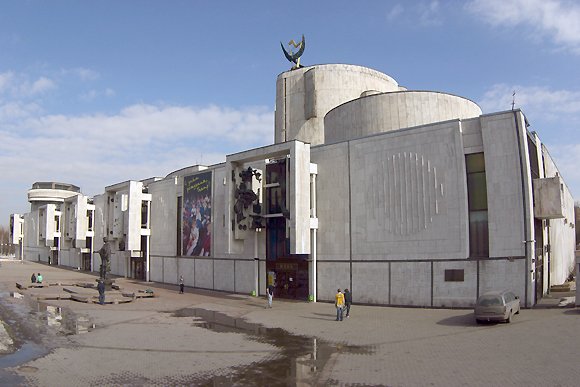 Canon D60. Zenitar F=16 mm But its distortions are also higher. We adjusted them with a program and got an expectable angle of view. But the wide-angle lens also introduces some distortions, so let's fix them and compare the angle of view again. When you rectify distortions, you should take into account the choice between right lines and right angles. It's up to you to decide - tastes differ, after all :-)  Canon D60, F16mm. Software correction of distortions. 
Canon 5D, F=24mm. Software correction of distortions. It's all easy with telephotos. The coefficient is true. Yep, one and the same lens will give different angles in these cameras. But except for the case with a fisheye, there will be no problem to find a lens with a given angle of sight for any smaller sensor. Authors often publish photos with frames that show what you will see on a photo with various lenses. Most images are calculated. I'll try to create a similar chart by using the results of shooting with specific lenses: 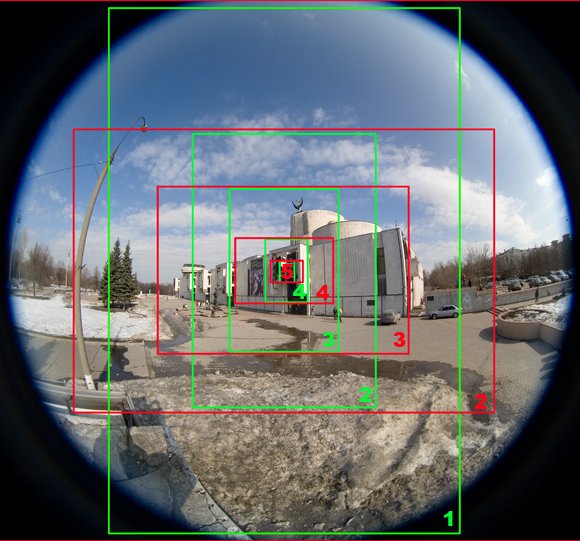
That's how I did it. I used a photo taken with the Peleng lens and superimposed photos, taken with other lenses, shrunken to match the scale, and then framed them. These very frames are shown on the photo, the image itself is taken with the Peleng lens, so its distortions are also there. The red frame limits the image in the lens of Canon 5D, the green frame - D60. Lens legend: AdaptersJOLOS shift adapterIt seems that a large sensor should allow to use efficiently lenses from medium-format cameras with shift adapters for taking architectural photos. But the reality is not that peachy. Indeed, compared to a cropped sensor, a 45mm lens can fit an object and correct perspective distortions by shifting. But using a standard lens and software correction of distortions will give the best results. Let's compare photos, taken with the Mir 26 shift lens and Canon 50/1.4 with software correction of distortions.
Adapter for capturing slidesUnlike the situation with a small sensor, described in the article Capturing Images from Photographic Films, this camera makes it easy: we take PZF and PD and use them in the standard way.  Canon EOS 5D + EOS-M42 lens adapter + PZF + Industar 61 + PD
|
||||||||||||||||||||||||||||||||||||||||||||||||||||||||||||||||||||||||||||||||
|
Article navigation: |
| blog comments powered by Disqus |
| Most Popular Reviews | More RSS |
 |
Comparing old, cheap solutions from AMD with new, budget offerings from Intel.
February 1, 2013 · Processor Roundups |
 |
Inno3D GeForce GTX 670 iChill, Inno3D GeForce GTX 660 Ti Graphics Cards A couple of mid-range adapters with original cooling systems.
January 30, 2013 · Video cards: NVIDIA GPUs |
 |
Creative Sound Blaster X-Fi Surround 5.1 An external X-Fi solution in tests.
September 9, 2008 · Sound Cards |
 |
The first worthwhile Piledriver CPU.
September 11, 2012 · Processors: AMD |
 |
Consumed Power, Energy Consumption: Ivy Bridge vs. Sandy Bridge Trying out the new method.
September 18, 2012 · Processors: Intel |
| Latest Reviews | More RSS |
 |
Retested all graphics cards with the new drivers.
Oct 18, 2013 · 3Digests
|
 |
Added new benchmarks: BioShock Infinite and Metro: Last Light.
Sep 06, 2013 · 3Digests
|
 |
Added the test results of NVIDIA GeForce GTX 760 and AMD Radeon HD 7730.
Aug 05, 2013 · 3Digests
|
 |
Gainward GeForce GTX 650 Ti BOOST 2GB Golden Sample Graphics Card An excellent hybrid of GeForce GTX 650 Ti and GeForce GTX 660.
Jun 24, 2013 · Video cards: NVIDIA GPUs
|
 |
Added the test results of NVIDIA GeForce GTX 770/780.
Jun 03, 2013 · 3Digests
|
| Latest News | More RSS |
Platform · Video · Multimedia · Mobile · Other || About us & Privacy policy · Twitter · Facebook
Copyright © Byrds Research & Publishing, Ltd., 1997–2011. All rights reserved.